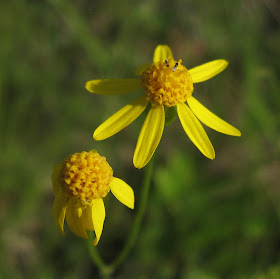"Look – to look at something for a reason, with an intention."
"See – anyone who is not blind can see, to see means to perceive anything in general. Seeing is not intentional, you see something because you can perceive it with your eyes."
Which brings us to one of my favorite odonate hunting spots on the north shore of Stoco Lake, where I look – with intention – not only for dragonflies and damselflies but species of any and all kinds that are new to me. Yet despite having surveyed this small area intensively for the past four years, I managed to overlook this small flower. It is by no means rare, there are dozens growing along the wet shoreline.
First, a few images of some Yellow Lady's Slippers found in the fen. The sepals and petals are definitly maroon and bit of red is just visible near the lip of the pouch in the second photo. Also looking at the habitat and their association with other Lady's Slippers that are already in full bloom, these are likely Cypripedium parviflorum.
The flowers are larger and the plants as a whole taller than the Lady's Slippers growing in the fen. The petals and sepals are distinctly green and there are no red markings in evidence around the pouch. Nor did these flowers have any scent – I'm learning slowly, but I am learning. So it's reasonable to conclude that we're looking at Large Yellow Lady's Slipper (Cypripedium pubescens var. pubescens).








































































